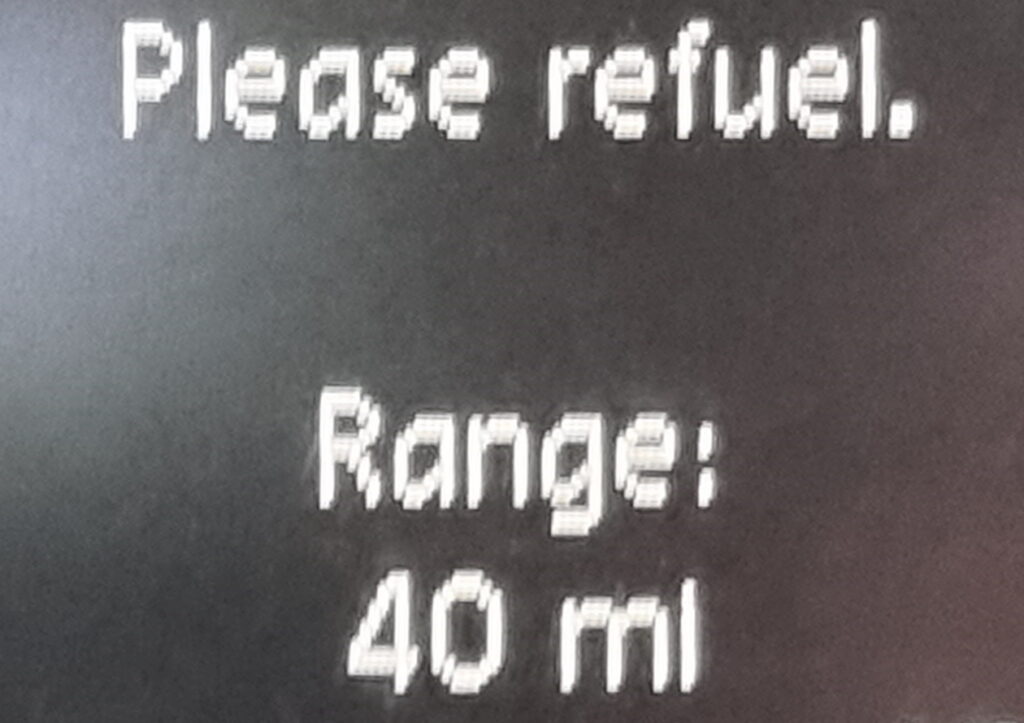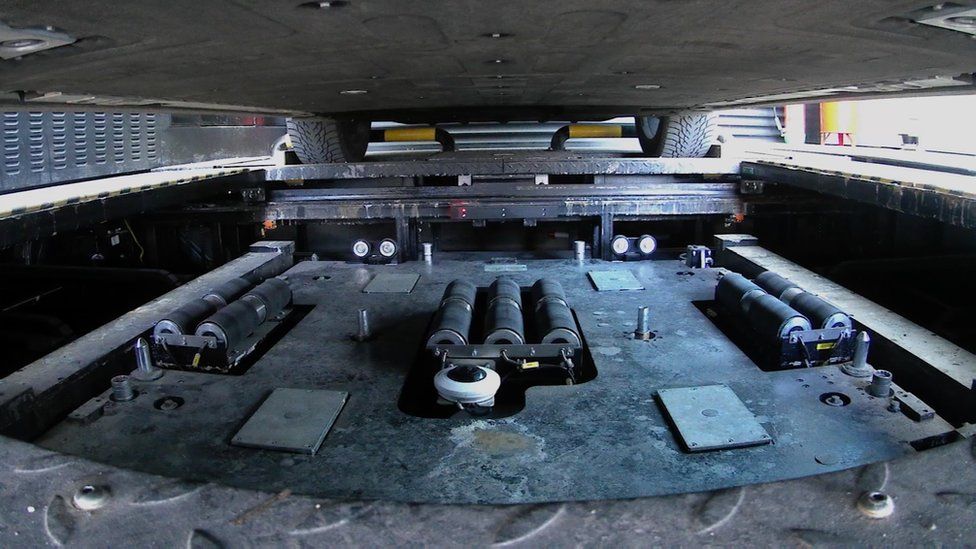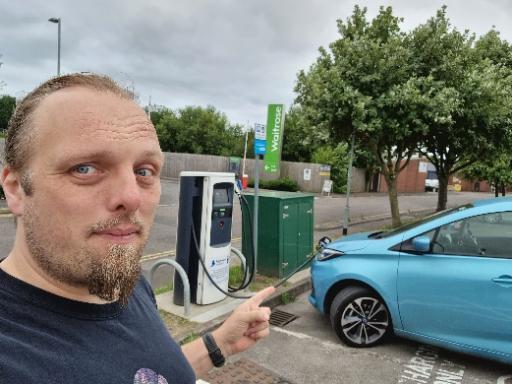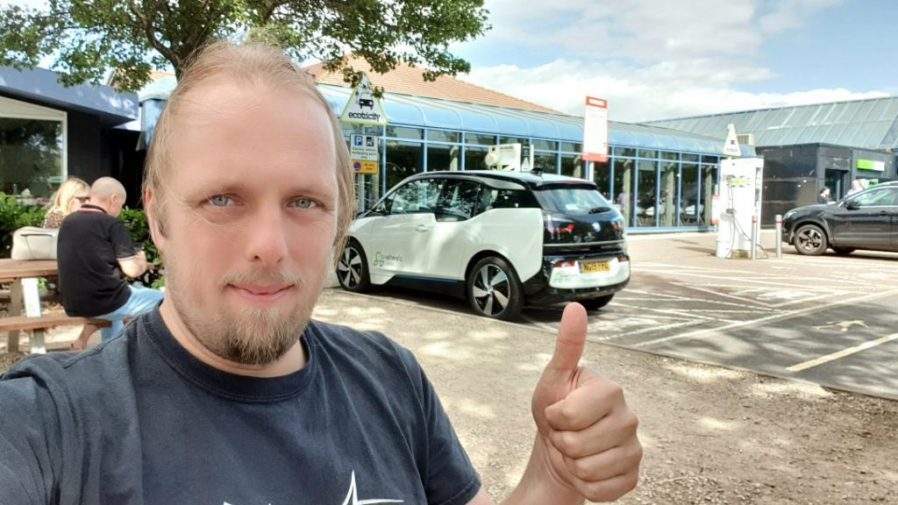Off to Pembrokeshire on holiday I’ve had to stop near Cardiff to put some more charge into the car… which provides the perfect opportunity for the doggo and I to explore a nearby sports field and take in All. The. Smells. 🐶
Tag: electric cars
Mathematics of Mid-Journey Refuelling
I love my electric car, but sometimes – like when I need to transport five people and a week’s worth of their luggage 250 miles and need to get there before the kids’ bedtime! – I still use our big ol’ diesel-burning beast. And it was while preparing for such a journey that I recently got to thinking about the mathematics of refuelling.

It’s rarely worth travelling out-of-your-way to get the best fuel prices. But when you’re on a long road trip anyway and you’re likely to pass dozens of filling stations as a matter of course, you might as well think at least a little about pulling over at the cheapest.
You could use one of the many online services to help with this, of course… but assuming you didn’t do this and you’re already on the road, is there a better strategy than just trusting your gut and saying “that’s good value!” when you see a good price?
It turns out this is an application for the Secretary Problem (and probably a little more sensible than the last time I talked about it!).

Here’s how you do it:
- Estimate your outstanding range R: how much further can you go? Your car might be able to help you with this. Let’s say we’ve got 82 miles in the tank.
- Estimate the average distance between filling stations on your route, D. You can do this as-you-go by counting them over a fixed distance and continue from step #4 as you do so, and it’ll only really mess you up if there are very few. Maybe we’re on a big trunk road and there’s a filling station about every 5 miles.
- Divide R by D to get F: the number of filling stations you expect to pass before you completely run out of fuel. Round down, obviously, unless you’re happy to push your vehicle to the “next” one when it breaks down. In our example above, that gives us 16 filling stations we’ll probably see before we’re stranded.
- Divide F by e to get T (use e = 2.72 if you’re having to do this in your head). Round down again, for the same reason as before. This gives us T=5.
- Drive past the next T filling stations and remember the lowest price you see. Don’t stop for fuel at any of these.
- Keep driving, and stop at the first filling station where the fuel is the same price or cheaper than the cheapest you’ve seen so far.

This is a modified variant of the Secretary Problem because it’s possible for two filling stations to have the same price, and that’s reflected in the algorithm above by the allowance for stopping for fuel at the same price as the best you saw during your sampling phase. It’s probably preferable to purchase sub-optimally than to run completely dry, right?
Of course, you’re still never guaranteed a good solution with this approach, but it maximises your odds. Your own risk-assessment might rank “not breaking down” over pure mathematical efficiency, and that’s on you.
Will swapping out electric car batteries catch on?
This is a repost promoting content originally published elsewhere. See more things Dan's reposted.
I won’t be plugging it in though, instead, the battery will be swapped for a fresh one, at this facility in Norway belonging to Chinese electric carmaker, Nio.
The technology is already widespread in China, but the new Power Swap Station, just south of Oslo, is Europe’s first.
…
This is what I’ve been saying for years would be a better strategy for electric vehicles. Instead of charging them (the time needed to charge is their single biggest weakness compared to fuelled vehicles) we should be doing battery swaps. A decade or two ago I spoke hopefully for some kind of standardised connector and removal interface, probably below the vehicle, through which battery cells could be swapped-out by robots operating in a pit. Recovered batteries could be recharged and reconditioned by the robots at their own pace. People could still charge their cars in a plug-in manner at their homes or elsewhere.
You’d pay for the difference in charge between the old and replacement battery, plus a service charge for being part of the battery-swap network, and you’d be set. Car manufacturers could standardise on battery designs, much like the shipping industry long-ago standardised on container dimensions and whatnot, to take advantage of compatibility with the wider network.
Rather than having different sizes of battery, vehicles could be differentiated by the number of serial battery units installed. A lorry might need four or five units; a large car two; a small car one, etc. If the interface is standardised then all the robots need to be able to do is install and remove them, however many there are.
This is far from an unprecedented concept: the centuries-old idea of stagecoaches (and, later, mail coaches) used the same idea, but with the horses being changed at coaching inns rather. Did you know that the “stage” in stagecoach refers to the fact that their journey would be broken into stages by these quick stops?
Anyway: I dismayed a little when I saw every EV manufacturer come up with their own battery standards, co=operating only as far as the plug-in charging interfaces (and then, only gradually and not completely!). But I’m given fresh hope by this discovery that China’s trying to make it work, and Nio‘s movement in Norway is exciting too. Maybe we’ll get there someday.
Incidentally: here’s a great video about how AC charging works (with a US/type-1 centric focus), which briefly touches upon why battery swaps aren’t necessarily an easy problem to solve.
Dan Q found GC811W7 SideTracked – Uttoxeter
This checkin to GC811W7 SideTracked - Uttoxeter reflects a geocaching.com log entry. See more of Dan's cache logs.
Passing through town I stopped to charge my car near Waitrose (pictured!), and as it filled up the battery tank I wandered over to find this cache. Coordinates might be off – my GPSr had me at the wrong side of the road! – but the hint was solid and after a little feeling-about free cache was in hand. TFTC.
30 Years in the making | The All-New Renault CLIO
This is a repost promoting content originally published elsewhere. See more things Dan's reposted.
Last week I happened to be at an unveiling/premiere event for the new Renault Clio. That’s a coincidence: I was actually there to see the new Zoe, because we’re hoping to be among the first people to get the right-hand-drive version of the new model when it starts rolling off the production line in 2020.
But I’ll tell you what, if they’d have shown me this video instead of showing me the advertising stuff they did, last week, I’d have been all: sure thing, Clio it is, SHUT UP AND TAKE MY MONEY! I’ve watched this ad four times now and seen more things in it every single time. (I even managed to not-cry at it on the fourth watch-through, too; hurrah!).
Dan Q found GC55HCZ Take a break!!
This checkin to GC55HCZ Take a break!! reflects a geocaching.com log entry. See more of Dan's cache logs.
The battery indicator on the eV I’m renting wasn’t confident that I’d make it all the way back home without a top-up, so I stopped for a 45 minute charge and a drink – the former for the car, the latter for me – at the services (pic attached of me at the chargers: this is nowhere near the GZ!) and figured I’d try to find the cache while I was waiting.
Coords took me to an unlikely looking spot and the hint wasn’t much use, so I looked at the logs and noticed that a few people had reported that they had found themselves on the “wrong side of the road”. That could be me, too, I thought… but the wrong way… in which direction? There were two roads alongside me.
I spotted a tall white thing that was different to the others and guessed that maybe that was what the hint referred to? When I got there, I even found a likely looking hiding place, but clearly my brain is still in USA-caching mode (I was caching on California a couple of weeks ago) because the hiding place I was looking at was the kind of “LPC” that just doesn’t happen over here. Damn.
So I stopped and tried to look nonchalant for a while, pacing around and looking for anything else that might fit the clue. Then I saw three things close together on the other-other side of the road and it immediately clicked that I was looking for something like them. I crossed over, sat down on the convenient perch while I waited for some muggles to pass, retrieved the cache and – at last – signed the log in what was basically the only remaining bit of space.
Had my GPSr sent me to the right place to begin with this adventure would have been much shorter, but I got there in the end… and still with 13 minutes of charging time left before I could drive away. TFTC!
New Tesla charging stations could compete with Starbucks
This is a repost promoting content originally published elsewhere. See more things Dan's reposted.
As Tesla expands its Supercharger network, the automaker intends to up its game, building higher-end, retail-rich locations that CEO Elon Musk has called “Mega Superchargers” but that we’ll call just Megachargers.
CEO Elon Musk has speculatively described them as “like really big supercharging locations with a bunch of amenities,” complete with “great restrooms, great food, amenities” and an awesome place to “hang out for half an hour and then be on your way.”
The move makes sense. Superchargers are currently located through the US and other countries, providing the fastest rate of recharging available to Tesla owners. The station can have varying numbers of charging stalls, however, and they aren’t always located in the best areas for passing the time while a Tesla inhales new electrons, although Tesla typically tries to construct them near retail and dining options…



